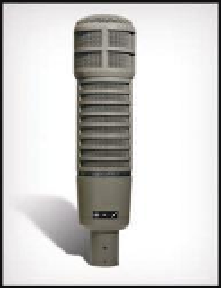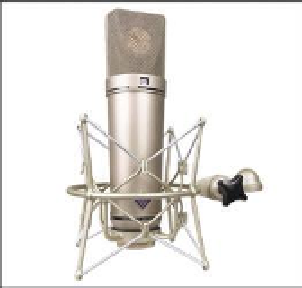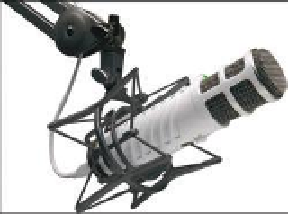Game Development Reference
In-Depth Information
times you might be using an interface to record that contains a mic
preamp, or perhaps a mixer. Whatever you use, you usually need to boost
the sound volume before sending it to the recording device.
There are many dif erent brands of microphones and also dif erent types.
There are Ribbons, Carbon and Crystals (used especially in the older days
of radio), but the two basic types we are concerned with these days are
called
dynamic
and
condenser
microphones. Let's start with dynamic
microphones:
Dynamic microphones
are the most common for live music and pop
music in general. They are generally the least expensive as well, and
usually require no external power. Dynamic microphones do not evenly
cover the entire frequency spectrum of sound. Because of this, they are
usually used in specialized applications in a studio setting and have
dif erent strengths and weaknesses. There are a few well-known mics
frequently used in radio that are occasionally used for voice-over work,
but it's not as common to i nd them used in the studio.
RE-20 microphone.
Condenser microphones
are more commonly used for professional voice
recording, and are generally more expensive than dynamic microphones.
They require external power to work, either in the form of a battery, or
phantom power, which is a type of voltage run over standard microphone
cables. Phantom power is more commonly used than batteries.
Condenser microphones usually have a much louder signal level than
dynamic microphones. These microphones of er a much broader
frequency response than dynamic microphones and are usually the tool
of choice in the recording studio for handling voice-over work. Here's a
few pics of well-known condenser mics:
Shure SM7 microphone.
Let's briel y look now at pickup patterns or polar patterns. These patterns
are coni gurations that a microphone uses to detect sounds around it.
AKG 414.
Neumann U87.
RODE Podcaster USB microphone.






































